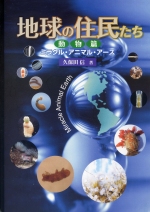|
*
|
|
Preface |
|
|
|
|
|
Description of 41 animal
phyla 1. Phylum
(Commentary: Click on the photo)
|
|
1
|
|
Phylum Protozoa Ameba, Euglena
- Mysterious single-cell fellows |
|
|
2
|
|
Phylum Monoblastozoa Salinella
- Miracle animal not in the textbook |
|
|
3
|
|
Phylum Placozoa Trichoplax
adhaerens
- The most primitive multi-cellular animal alive today |
LINK
|
|
4
|
|
Phylum Rhombozoa Dicyemida
- Parasites who reproduce bizarre ways |
|
|
5
|
|
Phylum Orthonectida Rhopalura
- “Mesozoan” hidden in various kinds of animals |
LINK
|
|
6
|
|
Phylum Porifera Sponge
- Sponges can regenerate after grind them down |
|
|
7
|
|
Phylum Cnidaria Jellyfish, corals,
and sea anemones
- Gastro-animals with venomous sting |
|
|
8
|
|
Phylum Ctenophora Comb jelly
- A kind of jellyfish that eats other jellyfish |
|
|
9
|
|
Phylum Platyhelminthes Planaria
- Ripping them apart into pieces and still alive |
LINK
|
|
10
|
|
Phylum Gnathostomulida Jaw worms
- Bilaterally-symmetric animals with strong jaws |
LINK
|
|
11
|
|
Phylum Nemertea Ribbon worms
- The first bilaterally-symmetric animals to have the anus |
LINK
|
|
12
|
|
Phylum Kinorhyncha Mud dragons
- Tiny animals with a segmented body |
|
|
13
|
|
Phylum Loricifera Nanaloricus
- Armored tiny deep-sea animals |
|
|
14
|
|
Phylum Gastrotrichia Chaetonotida,
Macrodasyoidea
- Meiobenthos covered with scales and spines |
|
|
15
|
|
Phylum Rotifera Wheel animals
- Microscopic, female-dominant animals living in the aquatic world |
LINK
|
|
16
|
|
Phylum Nematoda Round worms
- Lab animals with their genome fully sequenced first among animals |
|
|
17
|
|
Phylum Nematomorpha Horsehair
worms
- Absorb nutrients from the body surface |
|
|
18
|
|
Phylum Acanthocephala Thorny
headed worms
- Living as parasites from cradle to grave |
LINK
|
|
19
|
|
Phylum Priapulida Penis worms
- The name says it all |
LINK
|
|
20
|
|
Phylum Sipuncula Peanut worms
- Anus not in their butt |
LINK
|
|
21
|
|
Phylum Echiura Spoon worms
- Earthworm-like animals with a characteristic proboscis |
LINK
|
|
22
|
|
Phylum Annelida Lugworms, Earthworms,
and leeches
- Slender worms consisting of many segments |
LINK
|
|
23
|
|
Phylum Mollusca squids, octopus,
and shellfish
- Shells evolved into many shapes and forms |
LINK
|
|
24
|
|
Phylum Tardigrada Water bears
- Outstanding endurance: live more than 100 years |
LINK
|
|
25
|
|
Phylum Onychophora Velvet worms
- Intermediate form between lugworms and crabs |
LINK
|
|
26
|
|
Phylum Pentastoma Tongue worms
- Terrestrial vertebrates are the final host |
LINK
|
|
27
|
|
Phylum Chelicerata Spiders,
mites, and scorpions
- “Arthropods” with claw legs |
LINK
|
|
28
|
|
Phylum Crustacea Shrimps and
crabs
- Various arthropods that molt their carapace |
LINK
|
|
29
|
|
Phylum Hexapoda Insects
- The most diverse group of animals on the Earth |
LINK
|
|
30
|
|
Phylum Entoprocta Coloniales
- Colonial life at the bottom of the sea |
|
|
31
|
|
Phylum Cycliophora Symbion pandora
- Rare species with nesting reproduction |
|
|
32
|
|
Phylum Phoronida Phoronis
- Adults looking like a feather duster worm |
|
|
33
|
|
Phylum Ectoprocta Moss animals
- Colonial animals looking like plants |
LINK
|
|
34
|
|
Phylum Brachiopoda Lingulata
and Lamp shells
- Benthic animals having two shells like bivalves |
|
|
35
|
|
Phylum Pogonophora Beard worms
and giant tube worms
- Getting nutrients from symbiotic microbes |
LINK
|
|
36
|
|
Phylum Chaetognatha Arrow worms
- Chasing the prey like an arrow |
LINK
|
|
37
|
|
Phylum Echinodermata Sea urchins,
sea stars and sea cucumbers
- “Five” is the common number for these bottom dwelling animals |
LINK
|
|
38
|
|
Phylum Hemichordata Acorn worms
and Pterobranchia
- Free swimming life and bottom attached life |
LINK
|
|
39
|
|
Phylum Urochordata Sea Squirts
and Larvaceans
- Highly evolved invertebrates close to humans |
LINK
|
|
40
|
|
Phylum Cephalochordata Lancelets
- Highly evolved “Pseudo-fish” invertebrates |
LINK
|
|
41
|
|
Phylum Vertebrata Fish, Humans
and others
- Animals with back bones |
LINK
|
|
|
|
|
|
|
*
|
|
“Inhabitants on our Earth ? Animal
phyla” CD and DVD
Let’s familiarize yourself! “Inhabitants on our Earth ? |
LINK
|
|
*
|
|
Animal phyla” narration, images and
songs |
LINK
|
|
*
|
|
Animal taxonomy |
LINK
|
|
*
|
|
Key for 41 animal phyla |
LINK
|
|
*
|
|
Extant 41 animal phyla
on the Earth |
LINK
|
|
*
|
|
Conceptual graph
of animal phyla inter-relation |
LINK
|
|
*
|
|
References |
LINK
|
|
*
|
|
Author Profile |
LINK
|
|
*
|
|
Postscript |
LINK
|



